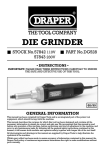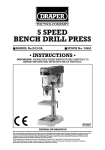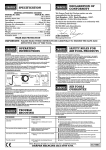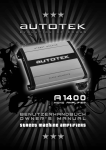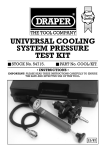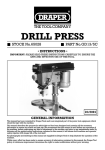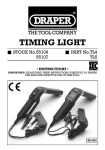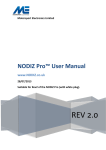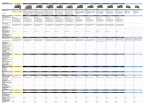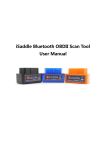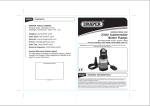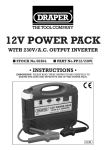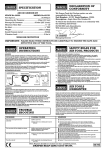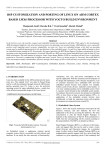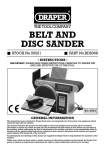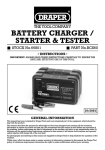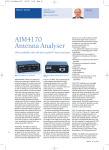Download FAULT CODE READER - Tooled
Transcript
FAULT CODE READER ■ STOCK No.54732 ■ PART No.FCR • INSTRUCTIONS • IMPORTANT: PLEASE READ THESE INSTRUCTIONS CAREFULLY TO ENSURE THE SAFE AND EFFECTIVE USE OF THIS TOOL. 01/2000 FAULT CODE READER ■ STOCK No.54732 CONTENTS: ■ PART No.FCR Page No. Declaration of Conformity ................................................................................1 Introduction......................................................................................................2 Safety Warning .................................................................................................3 Instructions..................................................................................................3-10 DECLARATION OF CONFORMITY We Draper Tools Ltd. Hursley Road, Chandler’s Ford, Eastleigh, Hampshire. SO53 1YF. England. Declare under our sole responsibility that the product: Stock Number:- 54732. Part Number:- FCR. Description:- Fault Code Reader. To which this declaration relates is in conformity with the following directive(s) 98/37/EC, 72/23/EEC & 89/336/EEC. With reference to: EN50144, EN55014, EN61000-3-2 & EN61000-3-3. JOHN DRAPER Managing Director 09/99 INTRODUCTION output after the codes for any present faults but Vauxhall codes are all output together (both present and past stored codes). Nearly all engines found in modern vehicles are fitted with a number of sensors and an Electronic Control Unit, which is often referred to as an ECU. The function of the engine sensors is to constantly send information to the electronic control unit (ECU) which monitors the performance of various areas of the engine. The ECU then analyses the information it has received and determines whether the values are within the manufacturer’s permitted specifications/tolerances, minor changes in value can be compensated for by the ECU. For example it can adjust/ determine the correct injection duration. However, if the ECU receives information from a sensor and the value is outside the manufacturer’s permitted specifications/tolerances then the ECU will recognise this as a fault as it is fitted with a pre-programmed self-diagnosis system. The ECU will then store the corresponding code in its memory for retrieval at a later date and in some cases will set the corresponding code in its memory for retrieval at a later date and in some cases will set itself to run on a pre-programmed emergency backup value otherwise known as ‘mapping’. This allows the vehicle to be driven to a garage or home etc. for fault diagnosis and repair. With use of a fault code reader the user can read fault codes that are present at the time of testing and the codes stored in the memory of the ECU then referring to the appropriate fault code reference tables the fault can be located quickly and accurately. These stored fault codes are output at different times depending on the vehicle make and model, i.e. stored Ford codes are The fault codes output from different manufacturers are not the same and the appropriate fault code reference table for the particular vehicle must be referred to, for instance, Ford vehicles output two or three digit codes whereas Audi vehicles output four digit codes. In most cases the codes will be displayed and read via the fault code reader itself, however some vehicles (Vauxhall) will be read by the fault code reader but displayed via the vehicle’s instrument panel. Vehicles fault code diagnostic sockets differ from manufacturer to manufacturer and this code reader is supplied complete with leads suitable for connection to Ford and Vauxhall vehicles. NOTE: The Ford adaptor lead supplied is suitable for use with the EEC-IV ECU. Once all faults have been located and rectified the fault codes can be erased from the ECU memory. On some vehicles this is carried out using the fault code reader but others, such as Vauxhalls, the power supply fuse to the ECU must be removed, or the negative terminal on the battery disconnected for approximately one minute. NOTE: If the battery terminal is disconnected other items such as radio, alarms etc. will need to be reset. ENSURE you have the relevant codes to reset them. If the codes cannot be erased as above then they will automatically be erased after approximately 20 cold starts (from cold to normal engine temperature). -3- SAFETY WARNING Please read the following instructions carefully, failure to do so could lead to personal injury or damage to the vehicle. 1. Avoid a dangerous environment. Do not expose the fault code reader to rain, ensure the work area is well lit. Always store the code reader in its case when it is not in use. 3. Never leave the code reader switched ON in a testing mode or when the code reader is switched ON and carrying out test procedures. Always switch the code reader and vehicle’s ignition off first. 4. Never leave the vehicle with the engine running – always switch the engine off before leaving the vehicle. 2. When using this code reader on a vehicle it may involve carrying out tests with the engine running and the following points should be followed to avoid injury. 5. Ensure the code reader is secure before starting any testing preferably attaching it to a body panel using the magnetic strip on the rear of the code reader. a) Wear proper clothing – do not wear loose clothing, neckties (rings, wrist watches) which could catch in moving parts. Non slip footwear is recommended.Wear a protective hair covering to contain long hair. Roll long sleeves above the elbow. 6. Check that all cables are kept clear of hot/moving parts. b) Do not over-reach – keep proper footing and balance at all times. 7. Only run the engine in a well-ventilated area. Do not inhale exhaust gases, as they are dangerous and can be fatal. Never run the engine in a garage or other confined area. INSTRUCTIONS FOR USE FORD VEHICLES INTRODUCTION This fault code reader is supplied complete with an adaptor lead for use with the Ford EEC-IV electronic control unit, Ford’s fourth generation of electronic engine control unit. This particular model of ECU unit was first introduced in 1985 and was used in all EFI engine vehicles from 1988/89 and almost all petrol engine Ford vehicles from 1991/2. There are several versions of the EEC-IV, the earlier versions used a 2-digit code system of which there were two types of coding. The later versions of the EEC-IV use a 3-digit code system. Refer to the Haynes Techbook supplied for further details on your vehicle. -4- INSTRUCTIONS FOR USE – FORD VEHICLES (Cont’d.) SELF-TEST/FAULT CODE READOUT SOCKET Most Ford vehicles fitted with the EEC-IV electronic control unit are equipped with a self-test/fault code readout socket. This socket has a black body with a red protective cap which can be removed to reveal the connector pins. The socket will be found in the engine compartment near to the bulkhead or battery. For more detailed information on where to find the socket refer to Haynes diagnostic fault codes manual supplied. CONNECTING THE FAULT CODE READER TO THE SELF-TEST/FAULT CODE READOUT SOCKET The Ford EEC-IV adaptor lead used to connect the fault code reader to the self test/fault code read out socket is supplied. Profile of Ford adaptor (plan view) Connect the adaptor lead to the fault code reader via the 5-pin din type connector. IMPORTANT: Before connecting the fault code reader to the self test/fault code readout socket ensure that a good battery is fitted to the code reader, the vehicle’s handbrake is applied, neutral (manual transmission) or ‘P’ (automatic transmission) is selected, ignition switched off, air conditioning (where fitted) and any other electrical loads, i.e. lights, fans etc. must all be turned OFF. Check that the code reader is switched off and in the standby position. Now connect the fault code reader to the vehicle’s read out socket. READING/UNDERSTANDING OUTPUT CODES Once the code reader is connected to the ECU and in the test mode the ECU will send coded pulses to the fault code reader which are then output by the fault code reader to the user in two ways – (a) audible (bleep), and (b) visual (blink) by the fault code indicator. (See table on page 5). The user simply counts the beeps or blinks which are output from the FCR to identify particular numbers/codes, i.e. number 3 would be output as three rapid pulses, so the user would hear three rapid bleeps and at the same time the fault code indicator would blink rapidly three times, indicating number 3. Number 8 would be output as eight rapid pulses, so the user would hear eight rapid bleeps and at the same time the fault code indicator would blink rapidly eight times indicating number 8. 2-DIGIT NUMBERS When reading a two digit number i.e. 69 the number will be output in two parts, first there would be six rapid bleeps/blinks then a short pause followed by nine further rapid bleeps/blinks indicating 69. 3-DIGIT NUMBERS This is very similar to reading 2 digit code numbers but the number will be output in three parts instead of two, i.e. 193 would be output as follows: first there would be one bleep/blink, a short pause, then nine rapid bleeps/blinks, a short pause then a further three bleeps/blinks indicating 193. -5- INSTRUCTIONS FOR USE – FORD VEHICLES (Cont’d). When in use it is likely that the FCR will output several 2 or 3 digit fault codes (depending on the age of the vehicle). the connector/wiring is at fault this will be evident by the engine’s response as contact is broken and remade. The FCR will also bleep and the LED indicator will be illuminated when the connection is broken and remade. If the standby/test switch is set to the standby position during the wiggle test all KAM (keep alive memory codes) will be erased. As explained above when the FCR is outputting say 2 digit codes there will be short pauses between the single codes output that make up the 2 digit code number. However, when it is outputting more than one 2 digit code there will be much longer pauses between the full output codes. Example: code output 23 followed by 48: Two rapid bleeps/blinks indicating 2, a short pause then three rapid bleeps/ blinks indicating 3 = 23. This would then be followed by a longer pause then four rapid bleeps/blinks indicating 4, a short pause then eight rapid bleeps/blinks indicating 8 = 48. GENERAL When the fault code reader is outputting current fault codes and any previously stored fault codes from the ECU memory there will be a long pause between the current and stored codes, or the code 1 may be heard. This single bleep/blink is called a separator code which helps the user distinguish between the current and stored fault codes. If there are no current or stored fault codes then 11 or 111 will be output. When a fault code is output it does not necessarily mean that the component indicated is at fault. The fault could be generated by another problem such as the component connector or wiring is faulty or has a poor/intermittent connection. It is therefore important that before replacing parts or units that the wiring and connectors are thoroughly checked. Also if multiple faults are indicated it is possible these are caused by a fault on one component giving incorrect readings. Therefore all components will need to be checked. WIGGLE TEST A further check of the wiring/connectors can be made whilst the engine is idling. Each sensor’s wiring can be wiggled and if TEST PROCEDURE – FORD 2-DIGIT FAULT CODES Preliminary checks: 1. Ensure that the vehicle’s ignition is switched off. 2. Check that all the sensor leads and connectors are secure and that the breather system is operating correctly. 3. If the vehicle is fitted with grounded octane/idle adjust wires the plug and socket must be disconnected (Fig.1). To locate this plug and socket refer to the vehicle manufacturer’s service manual. 4. The fault code reader must be switched off and the test switch in the standby position. Fig.1 Ford octane/idle white socket when connected (as seen in vehicle) TESTING/READING CODES (FORD 2-DIGIT) General 1. Connect the fault code reader to the diagnostic socket which is normally located near the bulkhead near the battery. If you are unable to locate the diagnostic socket refer to Haynes diagnostic fault codes manual supplied. -6- INSTRUCTIONS FOR USE – FORD VEHICLES (Cont’d.) 2. Switch the fault code reader on. It is now possible to carry out various test procedures: A. Ignition ON – engine OFF test 1. Turn the ignition to the ON position but do not start the vehicle. Have a piece of paper and a pen available to write down output codes. 2. Now to start the test push the standby/start switch to the start position and wait up to one minute for the codes to be output. During this time ignore any rapid pulses, you may also hear/see sensors starting/ stopping/moving – this is part of the OBD (on board diagnostics) carrying out tests. 3. Next the fault code reader will output codes as explained previously. The codes will be output in the following order: current fault codes, then stored fault codes sometimes referred to as KAM (keep alive memory) codes. Note the CODE TYPE Current code Current code (repeated) Separator code Stored KAM codes Stored KAM codes (repeated) Test completed CODE NO. 11 11 2 11 11 1 KAM (keep alive memory) will output both current and stored fault codes when read. There is a pause between the codes output and a longer pause between the present (current) and stored codes. On some systems code 2 will be output between the current and stored codes to help distinguish between them. This is known as a separator code. The codes output will be repeated after a short delay and the end of the test will be indicated by code number 1. 3. If no faults are found the code 11 will be output. After the code 1 has been output (indicating the end of the test) the OBD (on board diagnostic system) will be ready to start the wiggle test – refer to page 7. 3. For example, if there are no current or stored codes the following codes will be output. 11, 11, 2, 11, 11, 1. Meaning: MEANING No current codes No current codes Separator code. Separates the stored KAM codes & the current fault codes No stored codes No stored codes Ready to start wiggle test However, if for instance the output codes were: 11, 11, 2, 17, 17, 1 it would mean that there are no current fault codes but fault code 17 has been recorded sometime in the past and stored in the keep alive memory (KAM). If the output codes were: 22,30,39, 22,30,39, 2, 22,30,39,50, 1 it would indicate that faults 20, 30 and 39 are currently existing and fault 50 has been recorded sometime in the past and stored in the keep alive memory (KAM). Now the fault codes have been identified refer to the Haynes manual supplied. The codes stored in the KAM can be kept or erased. To erase the codes simply switch the standby/start switch to the standby position. To keep the stored codes turn the vehicle’s ignition off before switching the code reader to standby. B. Engine running test Note: Before commencing the engine running tests run the engine until it reaches normal operating temperature (if air conditioning is fitted to the vehicle switch it off). If the fault code reader is switched to ‘start test’ before the engine has reached normal operating temperature the test will not start until normal operating temperature has been reached. -7- INSTRUCTIONS FOR USE – FORD VEHICLES (Cont’d.) 1. Connect the fault code reader to the diagnostic socket as described earlier and switch it ON. Now put the standby/start switch to the ‘start’ position. 2. Start the vehicle’s engine. (If any rapid bleeps are heard this is just the OBD starting its test procedure.When used with some vehicles code 5 may be output and this indicates that the engine running test has started. The engine RPM (speed) will increase to approximately 2500 RPM for up to one minute then return to normal. 3. If code 2 is output carry out the following procedure: a. Fully depress the brake pedal. b. If the vehicle is fitted with power steering turn the steering wheel to full lock one way then centre it again. (This should send a signal from the power steering pressure switch to the ECU. If no signal is received then code 521 will be output). c. If the vehicle is fitted with automatic transmission press the override button on, then off. Now do the same for the sport/economy switch (where fitted). d. Wait for the code reader to output separator code 1. Then fully depress the accelerator pedal and release it again. Engine running test codes will now be output and all of these are repeated once. If no faults are found or present code 11 will be output as follows: 11, 11, 6. Code 6 indicates the engine running tests have been completed and the ECU is entering its service adjustment programme. This programme lasts for approximately two minutes. SERVICE MODE During the service mode the idle speed control valve is de-activated and the idle speed is set to its pre-programmed value. At this point it is possible to check and reset other basic settings (refer to vehicle manufacturer’s service manual). These adjustments cannot be made at any other time, as the ECU would not allow it. For a vehicle’s service mode data refer to Haynes diagnostic fault codes manual supplied. The end of the service mode will be indicated in one of several ways: a. The engine speed briefly increases and returns to normal as the idle speed control is re-activated. b. If code 5 was output earlier then code 6 or 7 will be output at the end of the service mode. If adjustments etc. have not been completed by the end of the service mode the engine on test should be repeated and the adjustments can then be completed. NOTE: Single digit codes transmitted i.e. 1, 6, 9 etc. can be referred to in the manufacturer’s service manual as 10, 60, 90 etc. CONTINUOUS TEST MODE NOTE: Before commencing the engine running tests the engine should be run until normal operating temperature is reached. (If air conditioning is fitted to the vehicle it must be switched off). If the fault code reader is switched to the ‘start’ position before the engine has reached normal operating temperature the test will not start until normal operating temperature has been reached. 1. Connect the FCR to the diagnostic socket. 2. Ensure the FCR is switched on and in the standby position. 3. Start the engine. 4. Switch the FCR to the ‘start’ position. Any existing fault codes will now be transmitted and repeated continuously. At this time it is possible to carry out a ‘wiggle test’ whereby various connectors can be checked as described earlier. Any fault codes will then be output. If no faults are present the code 11 will be output. -8- INSTRUCTIONS FOR USE – FORD VEHICLES (Cont’d.) end of the engine running tests it is possible to carry out a power balance test, enter the service mode or switch off the ignition and set the FCR to the ‘standby’ position. ERASING FAULT CODES FROM THE KAM The KAM (keep alive memory) can be erased in two ways. Either: a. By disconnecting the battery – however other memories will be lost such as radio and clock. Or: b. Follow the ignition on-engine off test described earlier and at the end of the test procedures set the test/standby switch to the standby position. RELAY TEST All relays and solenoids (except fuel pump and fuel injector) can be checked during this test. This test should be started at the end of the ‘ignition on – engine off test’ and is started by depressing the throttle pedal fully and releasing it again. This will switch all the relays and solenoids ‘ON’. Fully depressing the throttle pedal again and releasing will de-activate the relays and solenoids. 3-DIGIT SYSTEMS The Ford 2 and 3-digit systems are very similar to each other, the obvious difference being that the codes output on 2-digit systems are 2 digit and 3-digit systems output 3 digit codes. The codes output are read in the same way as the 2-digit system. For example, the no fault found code in 111 therefore if there are no current fault codes and no stored fault codes in the KAM memory then the codes output would be as follows: 111, 111, 1, 111, 111. If the codes output were: 111, 111, 1, 182, 182 it would indicate that there are no current fault codes but code 182 (meaning the idle mixture is too lean) has been stored in the KAM at some time. If the codes were: 182, 182, 1, 332, 332 it would indicate that the idle mixture is too lean (code 182) and that the EGR valve has not been opening (code 332) and this code has been stored in the KAM memory. POWER BALANCE TEST This test is started at the end of the ‘engine running test’. To start the test the engine RPM should be increased above 3000 RPM for approximately five seconds. Then release the throttle and the engine RPM will stabilise at around 1500 RPM. The OBD will then start the test and will cut the spark to each cylinder in turn. As the spark is cut to each cylinder there will be a drop in the engine speed, a weak or faulty cylinder will not effect the engine speed as much as a strong cylinder, and if a cylinder is not working at all then the engine speed will not be effected at all. However, it may not be the cylinder itself which is at fault but a faulty injection system or ignition. At the end of this test and all cylinders are equally balanced code 9 will be output. If any cylinder is weak then code number 1-8 will be output indicating which cylinder is not functioning correctly. IGNITION ON – ENGINE OFF TESTS Refer to ignition on – engine off tests in the Ford 2-digit section. ENGINE RUNNING TESTS Refer to the instructions for Ford 2-digit code systems, however, please note that once the test has started the OBD will transmit an identification code which corresponds with the number of cylinders. Code 2 indicates a 4-cylinder engine; code 3 indicates a 6-cylinder engine. After this code is output refer to 3a of engine running tests (Ford 2-digit systems). At the SERVICE MODE Refer to ‘service mode’ in Ford 2-digit systems section. ERASING FAULT CODES Refer to ‘erasing fault codes’ in the Ford 2-digit systems section. -9- INSTRUCTIONS FOR USE – GM/VAUXHALL/OPEL Engine management systems fitted to Vauxhall vehicles are mainly of Bosch or GM-multec origin including Bosch Motoronic and GM multec MPi and SPi. Other systems include Simtec and Bosch E2Plus. Each of the above ECU has a different system of on board diagnostics and fault code recording. However, other than different output codes the units are similar. The self diagnosis connector will be found on most Vauxhall vehicles either under the facia in the passenger compartment fuse box or in the engine compartment near to the fuse box. (Refer to the Haynes manual supplied with the fault code reader for further details). Note there are two types of connector plug fitted to Vauxhall vehicles and the connector plug supplied with the kit is suitable for both socket types. The codes output are identified the same way as the Ford codes – by counting the number of flashes. Refer to page 6 of this manual for further details. However instead of counting the flashes output on the fault code reader the codes will be flashed on the ‘check engine’ light on the dashboard. All codes will be displayed three times. If code 12 is displayed then this indicates no faults. TESTING PROCEDURE 1. Turn inginition off. 2. Connect the FCR to the diagnostic socket using the Vauxhall adaptor supplied in the kit. 3. Check that the FCR test switch is set to standby. 4. Turn on ignition but do not start the engine. 5. Set the test switch to the start position. 6. Write down the codes output from the ‘check engine’ indicator light on the dashboard. 7. Once you have identified the code numbers refer to the fault code tables listed in the Haynes manual supplied with this kit. 8. To stop the codes being output set the test switch to the standby position, turn off the ignition and disconnect the code reader. ERASING FAULT CODES Fault codes can be erased from the ECU if necessary – refer to the Haynes service manual supplied with this kit for further details on this procedure. - 10 - NOTES - 11 - DRAPER TOOLS LIMITED, Hursley Road, Chandler's Ford, Eastleigh, Hants. SO53 1YF. U.K. Helpline: (023) 8049 4344. Sales Desk: (023) 8049 4333. General Enquiries: (023) 8026 6355. Fax: (023) 8026 0784. www.draper.co.uk e-mail: [email protected] YOUR DRAPER STOCKIST ©Published by Draper Tools Ltd. No part of this publication may be reproduced, stored in a retrieval system or transmitted in any form or by any means, electronic, mechanical photocopying, recording or otherwise without prior permission in writing from Draper Tools Ltd.













